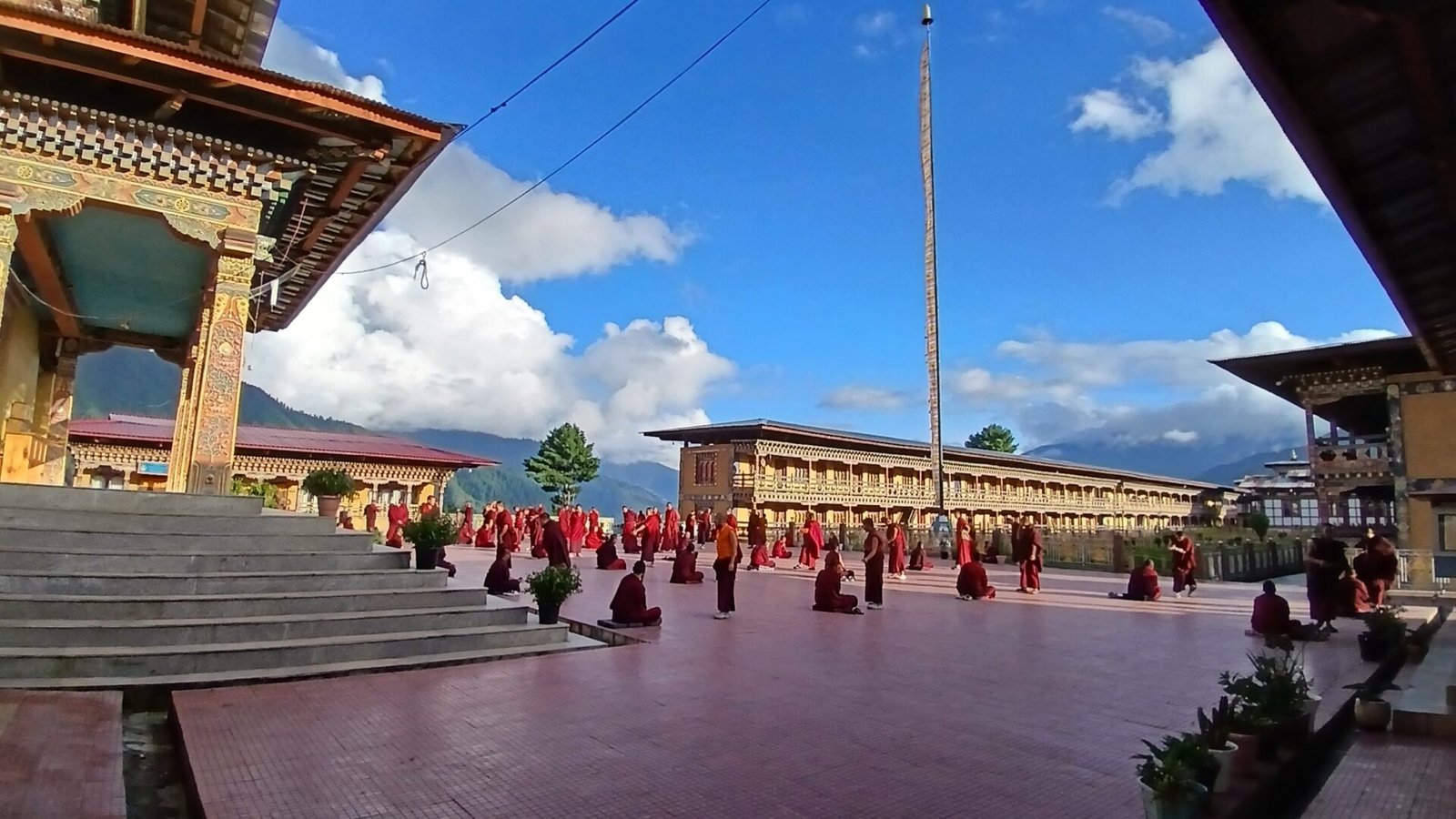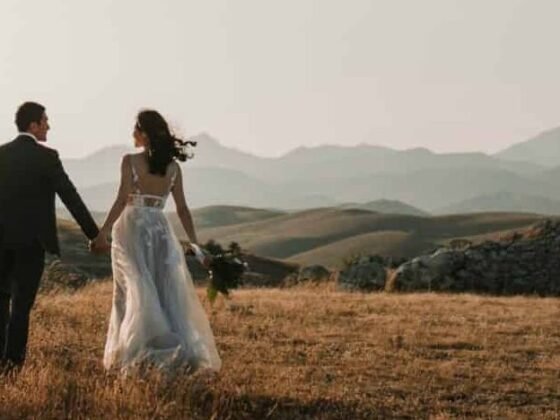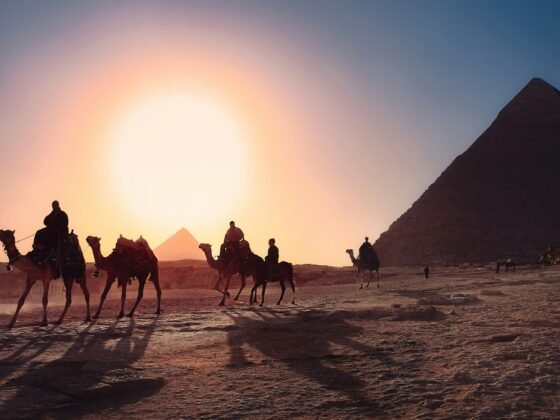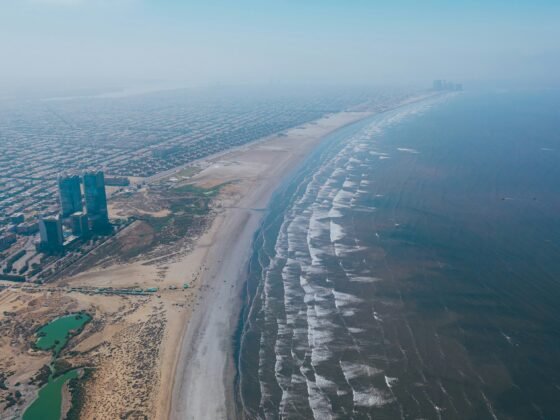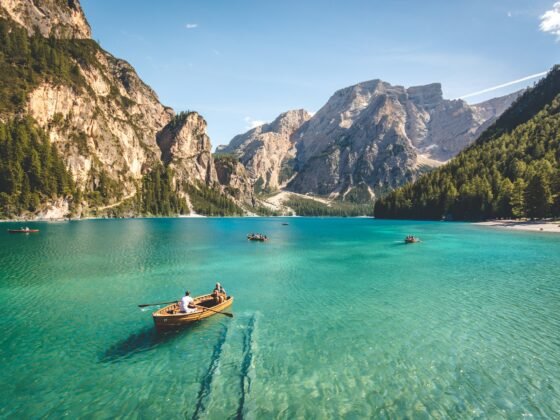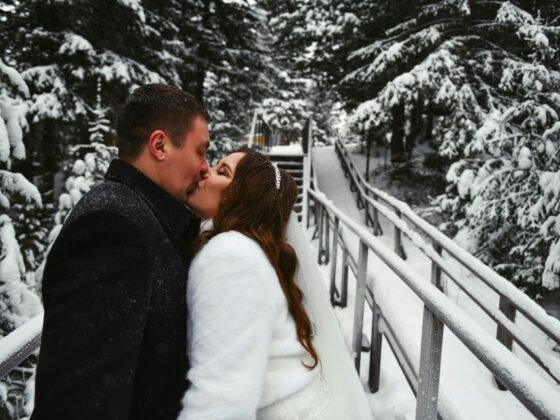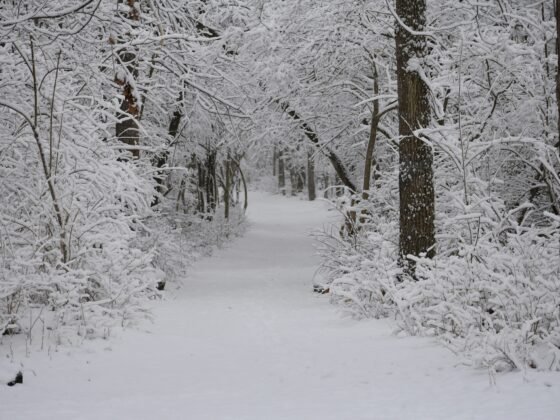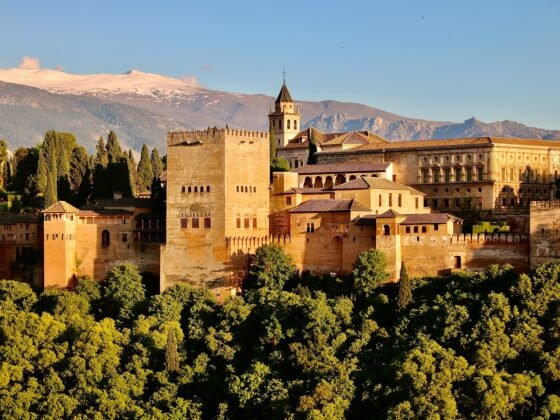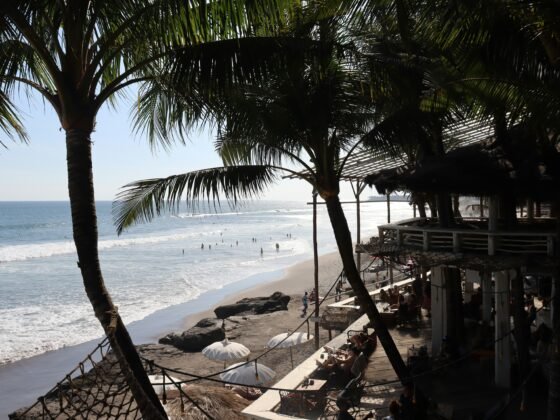Bhutan had been on my wish list for years, that small, mysterious Himalayan kingdom often described as the world’s happiest country. In the course of my career, I’ve travelled extensively in the Himalayas, especially when researching and writing the Footprint Handbook to Nepal. Bhutan was the last area of the range that I hadn’t visited and my expectations were high. It lived up to and exceeded all preconceptions I had.
When we descended into Paro Airport on a clear autumn morning, I understood why so few planes are allowed to land here. The approach is one of the most dramatic in the world, the aircraft weaving between snow-dusted peaks before skimming into a narrow valley flanked by forested hillsides and whitewashed houses. It felt like slipping into another world.
Thimphu: Where Tradition Meets Modern Bhutan
Our first night was in Thimphu, Bhutan’s capital but nothing like a capital city as most people know it. There are no traffic lights here, only a white-gloved policeman directing the few cars from a small booth in the centre of town, and the air feels fresh and cool, edged with pine. Monks walk past shopfronts selling both smartphones and prayer beads. Young couples share coffee beneath images of the royal family.
We visited the immense golden Buddha Dordenma, which gazes serenely down from the hillside above the city, and watched local archers practising their national sport at the Changlimithang range. In the market we bought chillies, hand-woven scarves, and packets of incense before retreating to a café for steaming momos and the national dish, ema datshi, chilli and cheese.
Thimphu was our introduction to Gross National Happiness, Bhutan’s unique measure of progress that prioritises wellbeing over GDP. Our guide Yeshey explained how it shapes daily life, from education to tourism policy. “We must balance happiness with preservation,” he said as we looked down over the valley, prayer flags snapping in the wind.
Dochula Pass to Punakha: Chortens in the Clouds
The following morning we set off east towards Punakha, climbing steeply out of the Thimphu Valley to Dochula Pass at 3,100 metres. Clouds rolled across the ridgeline, parting just long enough for us to glimpse the snow-covered Himalayas beyond. At the summit stand 108 memorial chortens, each one draped with strings of prayer flags. The air smelled faintly of juniper smoke from the offerings burning nearby.
From here the road descends into the subtropical Punakha Valley, where the climate is noticeably warmer and rice terraces cascade down to the rivers below. En route we stopped at Chimi Lhakhang, the Temple of Fertility, dedicated to the maverick 15th-century monk known as the Divine Madman, Drukpa Kunley. His teachings were famously unorthodox, using humour, song, and sometimes scandal to challenge hypocrisy, and his legacy lives on in the phallus symbols painted on local houses, said to ward off evil.
Punakha: Palaces, Rivers and the Spirit of the Divine Madman
We spent three nights in Punakha, staying in a beautiful villa at Pemako, a luxury retreat tucked into the hills with sweeping views of the valley. Each morning began with birdsong and the scent of magnolia drifting through the open windows.
Punakha’s star attraction is its dzong, an elegant fortress-monastery built at the confluence of the Pho Chhu and Mo Chhu rivers, known as the Palace of Happiness. It is considered one of the most beautiful in Bhutan, a place of significance both spiritual and political. This is where the King and Queen of Bhutan were married in 2011. We crossed the long wooden bridge and wandered its courtyards, where monks moved silently between whitewashed walls.
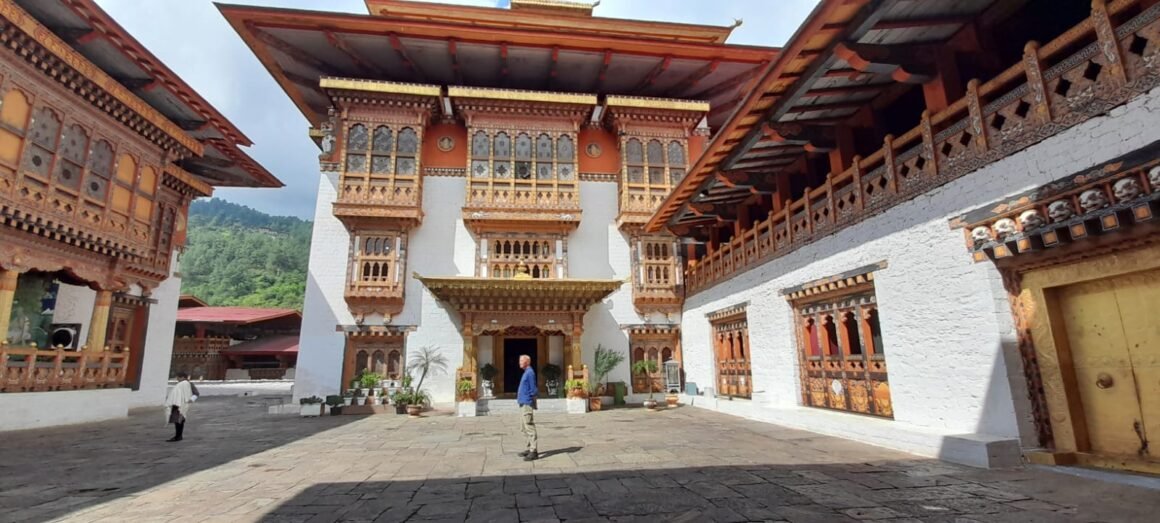
The author in the Palace of Happiness. Photo: Robert Ferguson
During our stay we walked and cycled through villages of traditional farmhouses, rice paddies, and suspension bridges lined with prayer flags. One afternoon we followed a trail through fields of mustard flowers to a small café overlooking the river for sweet milk tea. It was impossible not to feel content here, surrounded by such serenity and generosity of spirit.
Gangtey: A Valley of Cranes and Clouds
From Punakha we drove east towards Gangtey, also known as the Phobjikha Valley, a high glacial bowl surrounded by forested hills. The road wound up through rhododendron and dwarf bamboo until the valley opened like a secret garden, wide, grassy, and peaceful. During winter, black-necked cranes migrate here from Tibet, circling the Gangtey Gompa before settling in the fields below.
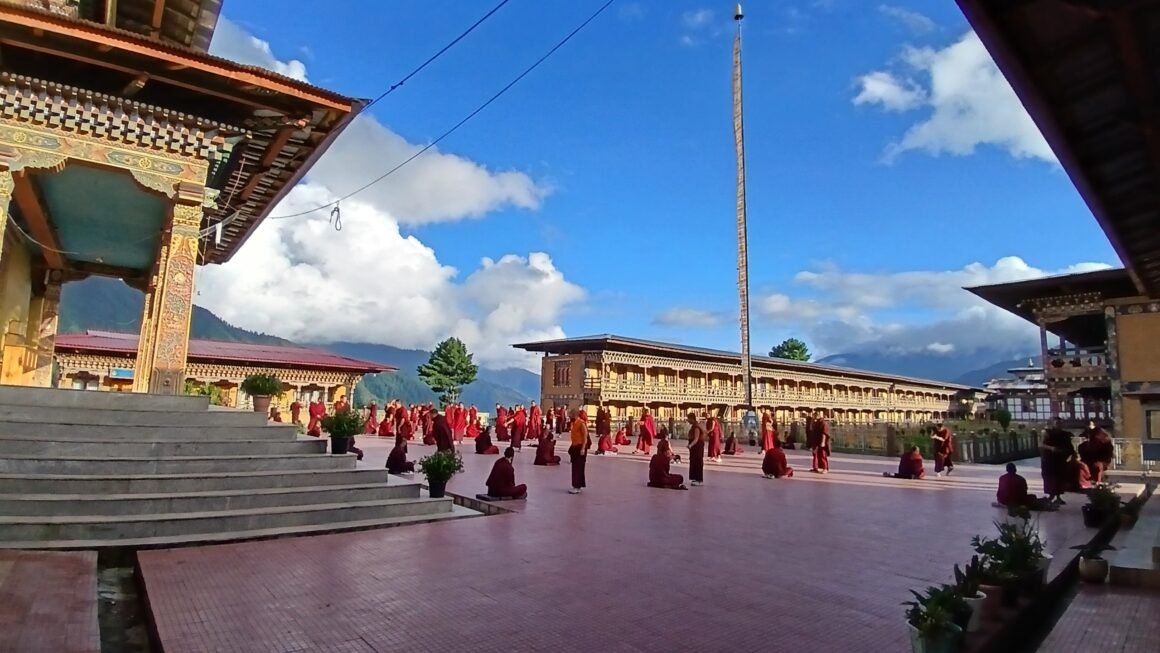
Monks in Gangtey practicing their debating. Photo: Robert Ferguson
Our base for three nights was the Gangtey Lodge, a warm, contemporary hideaway perched above the valley. It is one of those rare places that gets everything right, from the genuinely kind staff to the hand-carved wooden interiors and huge bathtubs positioned perfectly for sunset views. After days of hiking and biking, coming home to Gangtey Lodge felt like bliss.
We spent our time walking the Gangtey Nature Trail, meandering through pine forests and small hamlets where children ran to greet us. One morning we borrowed mountain bikes and followed the dirt tracks across the valley floor, prayer flags flapping beside us and yaks grazing in the distance.
On our final evening, we visited a nearby farmhouse for a traditional hot stone bath, a quintessential Bhutanese experience. Heated river stones were dropped into a wooden tub filled with herbal water until it reached the perfect temperature. As we soaked, the valley turned gold in the fading light and smoke curled up from kitchen chimneys. It was a moment of complete peace, punctuated only by the hiss of another stone being added to the water.
Tang Valley and Ogyen Choling: Stepping Back in Time
Beyond Gangtey lies Bumthang, the spiritual heartland of Bhutan, but before reaching it we made a detour into the remote Tang Valley. The long journey took us along winding mountain roads, past yak herders’ camps and small roadside shrines fluttering with prayer flags.
Our destination was Ogyen Choling, a historic noble family estate now converted into a small museum and guesthouse. Staying here felt like travelling back a century. We slept in creaky wooden rooms lined with family relics and ate dinner in the stone kitchen, our hosts serving red rice, buckwheat pancakes, and ema datshi. Delicious.
The next morning, we explored the estate’s private museum, which gives a rare insight into Bhutan’s feudal past, with masks, weapons, and manuscripts all carefully preserved. Later, we walked along the valley, the Himalayas to the north, meeting farmers drying buckwheat and women spinning wool in the sunshine. Few visitors make it here, which made it feel even more special.
Bumthang: The Spiritual Heart of Bhutan
The following day we walked up through its thick pine forests to a pass that looked west. Spread before us was Bumthang, often called the Switzerland of Bhutan, a landscape of rivers and pine-covered hills. It is dotted with ancient monasteries and temples linked to Guru Rinpoche, who brought Buddhism to Bhutan in the 8th century.
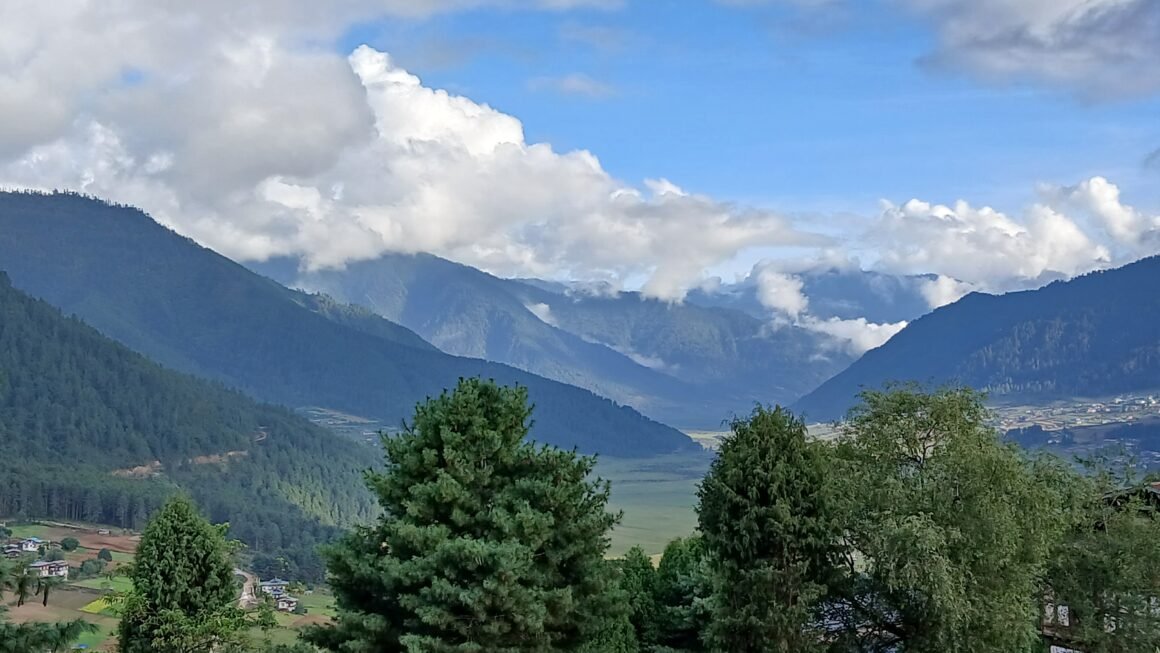
The Bumthang Valley. Photo: Robert Ferguson
We spent two days exploring the area by bike and on foot, visiting Jakar Dzong, Kurje Lhakhang, and Tamshing Lhakhang, where monks still hand-paint murals using natural pigments. At Kurje Lhakhang, our guide pointed out a rock said to bear the imprint of Guru Rinpoche’s body, left after he meditated there. Butter lamps flickered in the dim light and the scent of incense hung in the air.
Between monastery visits we stopped for coffee and apple pie, Bumthang’s orchards are famous, and sampled ara, the local spirit, at our guesthouse in the evening. Life here feels simple but deeply rooted in faith and community.
Return to Paro: The Final Ascent
Bumthang Airport was the most relaxed airport experience I’ve ever enjoyed and the best departure lounge, perfectly capable of handing its two departures a day.
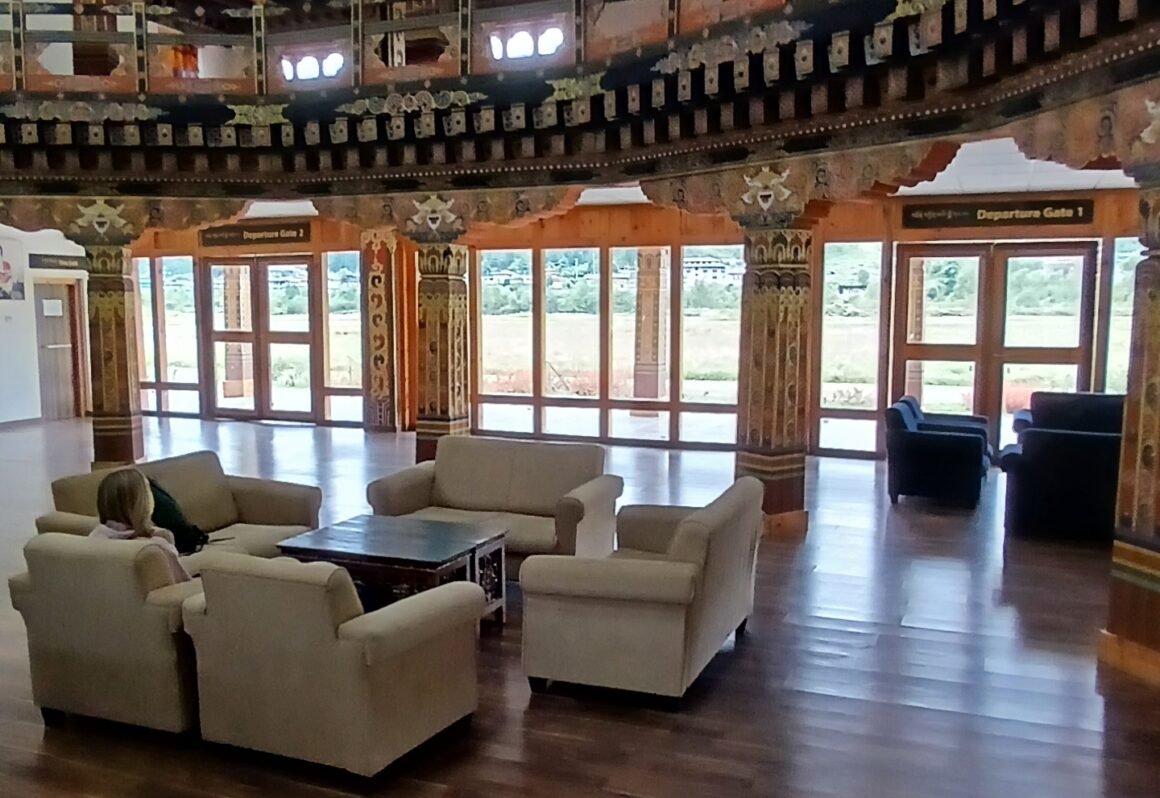
Departure Lounge at Bumthang Airport. Photo by Robert Ferguson
Our flight back to Paro was a reminder of Bhutan’s rugged geography. Valleys unfolded like folds of green silk, white rivers threading between them, and tiny clusters of houses clinging to the slopes. Back where we began, we had one final adventure, the climb to Taktsang Monastery, better known as Tiger’s Nest.
The trail begins with a steady ascent through pine forest scented with juniper. Prayer wheels line the path and horses occasionally pass carrying less-energetic pilgrims. After about two hours, the monastery appears, impossibly perched on a sheer cliff 900 metres above the valley. The story goes that Guru Rinpoche flew here on the back of a tiger to subdue a local demon, meditating in a cave for three months.
Standing before it, wind whipping the prayer flags, I felt an immense sense of awe. Inside, monks chanted softly, their voices echoing against the stone walls. It was a fitting finale to our journey, a moment of stillness that seemed to encapsulate Bhutan itself: sacred, timeless, and utterly captivating.
Reflections on the Land of the Thunder Dragon
Bhutan is not a destination that can be rushed. Its roads are winding, its valleys deep, and its rhythm deliberately slow. But that is its magic. From the warmth of our hosts in Punakha and the grace of the monks in Bumthang to the silent sweep of cranes across Gangtey’s sky, every experience felt personal and profound.
The country’s careful approach to tourism means that visitor numbers remain low, helping preserve the culture and environment that make it so special. It is a place where progress is measured in happiness and harmony, not wealth, and after ten days among its valleys and temples, that philosophy made perfect sense.
As our plane lifted off from Paro, banking between the peaks, I looked down at the ribbons of prayer flags fluttering below and felt an unexpected calm. Bhutan had worked its quiet magic, a reminder that the richest journeys are not measured in miles but in meaning.
When to Go
The best time to visit Bhutan is in spring (March to May) or autumn (September to November) when skies are clear and the valleys are lush. Spring brings rhododendron blooms, while autumn offers crisp air and mountain views at their best. Winter can be cold in higher regions like Gangtey but beautifully quiet and ideal for seeing black-necked cranes. The monsoon season, from June to August, is less suitable for travel due to heavy rain and occasional landslides.
FAQs
What is Bhutan best known for? Bhutan is best known for its deep-rooted Buddhist culture, breathtaking Himalayan scenery, and unique philosophy of Gross National Happiness, which prioritises wellbeing over economic growth. The country’s dzongs, or fortress-monasteries, stunning valleys, and colourful festivals, such as the Paro and Thimphu Tshechus, offer a glimpse into a timeless way of life. Known as the Land of the Thunder Dragon, Bhutan is also recognised for its commitment to environmental protection as the world’s only carbon-negative nation, with over 70 percent of its land covered by forest.
Is Bhutan good for tourists? Yes, Bhutan is an excellent destination for travellers seeking nature, culture, and tranquillity. Its limited-visitor policy means tourism remains sustainable and uncrowded. Visitors can hike through pristine mountain landscapes, visit centuries-old monasteries, experience vibrant festivals, and engage with local people who are genuinely welcoming. The country’s lodges and boutique hotels, such as Gangtey Lodge or Pemako in Punakha, offer exceptional comfort and views. Although travel is guided and structured, this ensures both a richer cultural experience and that tourism directly supports Bhutan’s environment and communities.
Do we have to pay $1200 per day in Bhutan? No, visitors no longer pay the old all-inclusive daily tariff of around $250 per person, which was sometimes confused with being much higher. Instead, Bhutan now requires tourists to pay a Sustainable Development Fee (SDF) of US$100 per person per night (as of 2025), plus the cost of accommodation, transport, and guides. Travellers can choose from a range of hotels and experiences to suit their budget and travel style. The SDF goes directly to funding education, healthcare, and conservation projects across Bhutan, ensuring that tourism benefits both people and nature.

